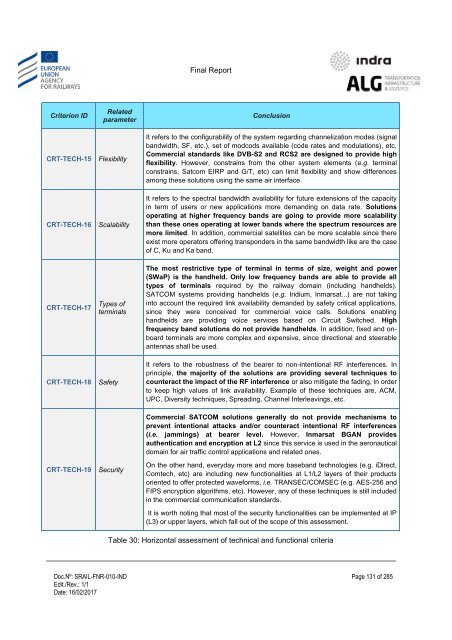Study on feasibility of SATCOM for railway communication
SRAIL-FNR-010-IND%20-%20FinalReport_v1.1_20170216
SRAIL-FNR-010-IND%20-%20FinalReport_v1.1_20170216
You also want an ePaper? Increase the reach of your titles
YUMPU automatically turns print PDFs into web optimized ePapers that Google loves.
Final Report<br />
Criteri<strong>on</strong> ID<br />
CRT-TECH-15<br />
Related<br />
parameter<br />
Flexibility<br />
C<strong>on</strong>clusi<strong>on</strong><br />
It refers to the c<strong>on</strong>figurability <strong>of</strong> the system regarding channelizati<strong>on</strong> modes (signal<br />
bandwidth, SF, etc.), set <strong>of</strong> modcods available (code rates and modulati<strong>on</strong>s), etc.<br />
Commercial standards like DVB-S2 and RCS2 are designed to provide high<br />
flexibility. However, c<strong>on</strong>strains from the other system elements (e.g. terminal<br />
c<strong>on</strong>strains, Satcom EIRP and G/T, etc) can limit flexibility and show differences<br />
am<strong>on</strong>g these soluti<strong>on</strong>s using the same air interface.<br />
CRT-TECH-16<br />
Scalability<br />
It refers to the spectral bandwidth availability <strong>for</strong> future extensi<strong>on</strong>s <strong>of</strong> the capacity<br />
in term <strong>of</strong> users or new applicati<strong>on</strong>s more demanding <strong>on</strong> data rate. Soluti<strong>on</strong>s<br />
operating at higher frequency bands are going to provide more scalability<br />
than these <strong>on</strong>es operating at lower bands where the spectrum resources are<br />
more limited. In additi<strong>on</strong>, commercial satellites can be more scalable since there<br />
exist more operators <strong>of</strong>fering transp<strong>on</strong>ders in the same bandwidth like are the case<br />
<strong>of</strong> C, Ku and Ka band.<br />
CRT-TECH-17<br />
Types <strong>of</strong><br />
terminals<br />
The most restrictive type <strong>of</strong> terminal in terms <strong>of</strong> size, weight and power<br />
(SWaP) is the handheld. Only low frequency bands are able to provide all<br />
types <strong>of</strong> terminals required by the <strong>railway</strong> domain (including handhelds).<br />
<strong>SATCOM</strong> systems providing handhelds (e.g. Iridium, Inmarsat...) are not taking<br />
into account the required link availability demanded by safety critical applicati<strong>on</strong>s,<br />
since they were c<strong>on</strong>ceived <strong>for</strong> commercial voice calls. Soluti<strong>on</strong>s enabling<br />
handhelds are providing voice services based <strong>on</strong> Circuit Switched. High<br />
frequency band soluti<strong>on</strong>s do not provide handhelds. In additi<strong>on</strong>, fixed and <strong>on</strong>board<br />
terminals are more complex and expensive, since directi<strong>on</strong>al and steerable<br />
antennas shall be used.<br />
CRT-TECH-18<br />
Safety<br />
It refers to the robustness <strong>of</strong> the bearer to n<strong>on</strong>-intenti<strong>on</strong>al RF interferences. In<br />
principle, the majority <strong>of</strong> the soluti<strong>on</strong>s are providing several techniques to<br />
counteract the impact <strong>of</strong> the RF interference or also mitigate the fading, in order<br />
to keep high values <strong>of</strong> link availability. Example <strong>of</strong> these techniques are, ACM,<br />
UPC, Diversity techniques, Spreading, Channel Interleavings, etc.<br />
CRT-TECH-19<br />
Security<br />
Commercial <strong>SATCOM</strong> soluti<strong>on</strong>s generally do not provide mechanisms to<br />
prevent intenti<strong>on</strong>al attacks and/or counteract intenti<strong>on</strong>al RF interferences<br />
(i.e. jammings) at bearer level. However, Inmarsat BGAN provides<br />
authenticati<strong>on</strong> and encrypti<strong>on</strong> at L2 since this service is used in the aer<strong>on</strong>autical<br />
domain <strong>for</strong> air traffic c<strong>on</strong>trol applicati<strong>on</strong>s and related <strong>on</strong>es.<br />
On the other hand, everyday more and more baseband technologies (e.g. iDirect,<br />
Comtech, etc) are including new functi<strong>on</strong>alities at L1/L2 layers <strong>of</strong> their products<br />
oriented to <strong>of</strong>fer protected wave<strong>for</strong>ms, i.e. TRANSEC/COMSEC (e.g. AES-256 and<br />
FIPS encrypti<strong>on</strong> algorithms, etc). However, any <strong>of</strong> these techniques is still included<br />
in the commercial communicati<strong>on</strong> standards.<br />
It is worth noting that most <strong>of</strong> the security functi<strong>on</strong>alities can be implemented at IP<br />
(L3) or upper layers, which fall out <strong>of</strong> the scope <strong>of</strong> this assessment.<br />
Table 30: Horiz<strong>on</strong>tal assessment <strong>of</strong> technical and functi<strong>on</strong>al criteria<br />
Doc.Nº: SRAIL-FNR-010-IND<br />
Edit./Rev.: 1/1<br />
Date: 16/02/2017<br />
Page 131 <strong>of</strong> 285


